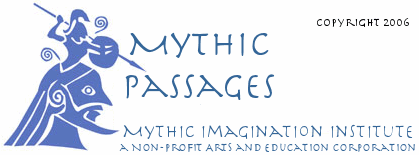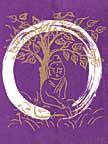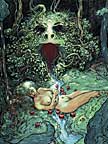|


The Many Deities of Neil Gaiman's American Gods
by by William Doty, Ph. D.,
William Doty, Ph.D. is Professor Emeritus of Humanities and Religious Studies
at the University of Alabama and former editor of Mythosphere: A Journal for
Image, Myth and Symbol. Dr. Doty is a prolific writer, translator, and
editor who has published more than twenty books and seventy essays in a wide
range of journals on topics including religious studies, anthropology,
psychology, classics, and art criticism. His best known books include Mythography:
The Study of Myths and Rituals, Myths of Masculinity, and Myth: A
Handbook.
Just released from prison, Shadow finds his seat at the back of the airplane,
only to discover that the woman passenger already ensconced there had been
assigned the same seat number. The stewardess says not to worry, and seats him
in the single remaining first class seat. The man next to him already knows his
name and says he wants to employ the well-muscled Shadow. Later during the
flight he says he's sorry to hear about his wife and best buddy being killed in
the car accident.
And whoa, we're in a sorta quasi-magical atmosphere just short of Stephen King.
But then already in prison, Shadow had been teaching himself how to make coins
magically disappear and reappear. And when it turns out that the man beside him
is named "Wednesday," it begins to be evident that he is an incarnation of the
Germanic god Wotan (or Wodan: hence Wodenstag, Wednesday). The almost
s.f.-magical aura spans the narrative: toward the end of the novel, Shadow
"reached into Chad Mulligan's mind, easy as anything, and he plucked the events
of that [painful to remember] afternoon out from it as precisely and
dispassionately as a raven picks an eye from roadkill" (573).
I made a passing reference in my February column to American Gods
, noting that it parsed a reference to the African Ananse figure in the guise
of the character Mr. (or Aunt) Nancy. But the trickster figure is never merely
single, often polymorphous, and polymorphous slides easily into polytheistic
("many imaged" --> "many deities"). Here I focus less upon the trickster
than the polytheistic panoply of sacred/mythological families of deities
represented in this large and complex novel.
Certainly American Gods is a postmodern work--meaning, of course, not after
modernity, but infected with modernity and its later viruses. One might as well
label its climate "postchristian," for one Judaeo-Christian apocalyptic
theme--"the Storm"--surfaces here repeatedly. And few contemporary works manage
to stuff into the minestrone pot so many figures from antiquity: Bast, Odin,
Media (Medea), Loki, Thoth, Anubis, the Three Norns, Kali, the Valkyries,
Ganesa, Ibis, Horus, and others. And the deities are mixed with historical
figures: on one page alone we find the Czech Czernobog, Elvis, Mr. Nancy,
Wotan, a 1970 VW bus, in addition to the tallest dwarf in America, Alvis Son of
Vindalf. Nor do inviduals stay dead: Shadow's love Laura returns in visionary
scenes, and after Wotan is shot by a laser weapon, he also reappears in
Shadow's dreams.
This is not one of those works that seek merely to update the antique
figures--though it does do that--so much as to insight aspects of the old
characters seldom realized before. This is a carnival
of deities, albeit with scenes of pain and pathos and tragedy, beginning when
Shadow undergoes horrifically-beaureaucratic prison exit-interviews only to be
released a week early because his marital partner has been killed.
The revelation that she died with the penis of his former and presumably future
employer in her mouth jerks the story into hyperdrive, and one of several
almost-surreal sequences of events. On his way home, Shadow finds his prepaid
airline trip malfunctioning. As noted, he gets upgraded fast--and a magical
realism begins, that returns many times during the novel. Even when he takes
unexpected alternative modes of transportation, Wednesday always appears just a
step ahead of him.
Shadow, who intelligently spent his three years in prison strengthening his
body, is referred to repeatedly as "Big guy," yet "dumb like Thor." However in
this world physical strength is less important than psychological prowess, and
Shadow slowly learns across the course of the narrative to cover his own ass
while simultaneously protecting Wednesday's. Shadow is the driver, the
assistant, the fall-guy, who nevertheless comes out ahead in the long run, even
though the ghost of his wife returns often enough to keep him on a razor's
edge.
The "true or false?" issues of postmodernist writing recur: Are there really
only three Fates? And the typical lack of narrative coherence in such
writing is present yet today: several non-sequential scenes focused upon
Russian characters verge upon early twen-cen surrealist visions such as Buñuel
and Dali's film Un chien andalou. Or we can speak of manipulations of
reality-plans: anticipating a straight cocktail, Shadow is given glasses of
honey-derived mead to cement his being hired by Wednesday; and of time--waiting
to be booked into jail, Shadow wades through many issues of Sports Illustrated
and Newsweek
, in what seems to be first minutes and then hours in a waiting room.
Also in high postmodernist dudgeon, there are long riffs of dialogue that might
be found in the writings of William Burroughs. One begins (394) "I can believe
things that are true and I can believe things that aren't true and I can
believe things where nobody knows if they're true or not. I can believe in
Santa Claus and the Easter Bunny and Marilyn Monroe and the Beatles and Elvis
and Mister Ed." If the reference to Burroughs is indirect, the direct citation
of another postmod odyssey (473) , Pynchon's Gravity's Rainbow
, is clearly meant as a paean to that work.
One might also suspect side glances toward Thomas Kuhn's The Structure of
Scientific Revolutions
: "We were discussing the ways to deal with the paradigm shift" (408 and
elsewhere). No wonder "See Rock City" signs turn up in the pantheon (485). Nor
is there great centering coherence (the modernist goal): in fact, Wotan reports
that marshalling the gods is like herding cats into straight lines (385). This
is problematic insofar as Gaiman's characters suggest that "all the gods that
people have ever imagined are still with us today" (395): a clever version of
the "attic" of Egyptian religions, where earlier deities were never discarded,
but allowed to compost and self-fertilize.
Here there is a suggestion (396) that there is no room for all of them to
coexist--so that a Storm/War between them may result (part 3 is entitled The
Moment of the Storm). Is that what is happening in the competitions
between the western Abrahamic traditions (Judaism, Christianity, Islam) today?
Yet in the novel there is still communication and conversation: repeatedly
earlier television figures speak to Shadow as if he were contemporary: Lucille
Ball asks "Wanna see my tits?" and the cast of Cheers
gives him live advice.
I suspect even a riff on Joseph Campbell's famous passage on the second page of
Hero with a Thousand Faces
: "The latest incarnation of Oedipus, the continued romance of Beauty and the
Beast, stand this afternoon on the corner of Forty-second Street and Fifth
Avenue, waiting for the traffic light to change." Here's the Gaiman: "The Queen
of Sheba, half-demon, they said, on her father's side, witch woman, wise woman,
and queen [...] stands on the sidewalk of Sunset Boulevard at 2.00 a.m. staring
blankly out at the traffic like a slutty plastic bride on a black-and-neon
wedding cake" (373).
What sort of a mind develops such themes as I have sketched here? Well, because
of Shadow, the world is changing (582). The novel ends in
what Northrop Frye would call the archetype of Spring: "Myths of the birth of
the hero, of revival and resurrection [...] of the defeat of the powers of
darkness, winter, and death." I continue to believe that creative artists
expose where a society is moving en avant
: what else can we learn from the Cubists and Surrealists of the early
twen-cen? Or currently from the sky-reaching architects such as Santiago
Calatrava and Frank Gehry, or Christo's spritefully-orange Gates in Central
Park?
That Gaiman, a Brit now living in the US, describes the panoply as American
seems strange, during a period of right-wing fundamentalist capture of much of
our politics and religion. Yet perhaps he is a harbinger of some new breezes in
the winds, fragrances of new, more-liberated visions of our customary everyday.
And suggestions that traditional models of the religious/mythological are
shifting and changing in ways never suspected in traditional societies.
Works Cited
Campbell, Joseph. 1968. The Hero with a Thousand Faces . 2nd ed.
Princeton: Princeton UP.
Doty, William G. 2006. "The Trickster Ananse Redux." Mythic Passages
02.06.
Frye, Northrop. 2001 [1951]. “The Archetypes of Literature.” Vincent B.
Leitch, ed. The Norton Anthology of Theory and Criticism . New
York: Norton; 1442-57.
Gaiman, Neil. 2001. American Gods . New York: HarperTorch-
HarperCollins.
Kuhn, Thomas S. 1970. The Structure of Scientific Revolutions . 2nd
ed. Chicago: U of Chicago P.
Pynchon, Thomas. Gravity's Rainbow. 1973. New York: Viking.
Return to Passages
Menu
Subscribe to the Passages
e-zine
|









